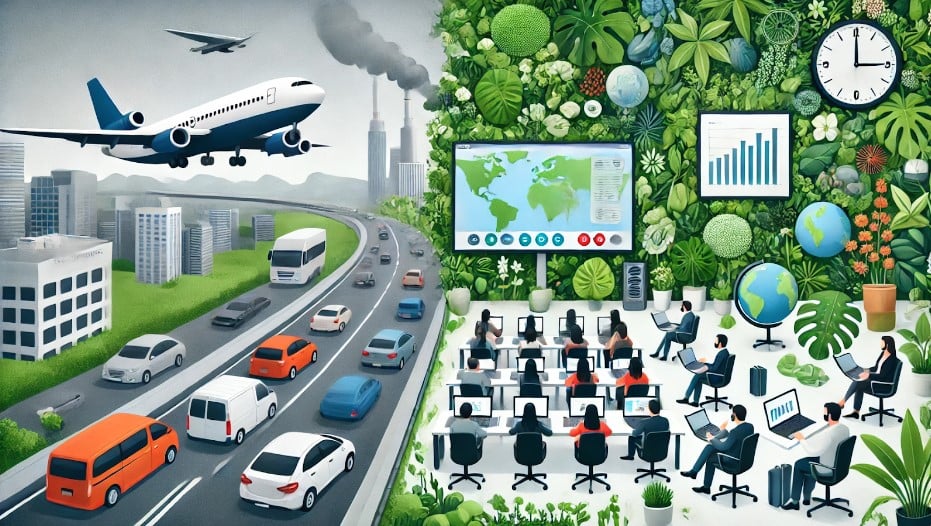Introduction
Sustainability has become a top priority for businesses worldwide. As the fight against climate change intensifies, companies are looking for ways to reduce their carbon footprint. One of the most effective ways to do this is by using video conferencing.
Video conferencing software, such as Microsoft Teams and Zoom, enables businesses to meet without travelling. This cuts down on carbon emissions from flights and car trips. It also reduces the need for large offices, saving energy and resources. In this article, we’ll explore how video conferencing can help businesses meet their sustainability goals.
Why Sustainability Is Important Today
Today, sustainability is not just an option—it’s a must. Businesses are being held responsible for the greenhouse gas emissions they produce. To address this, many are adopting new ways of working, such as using video conferencing technology and promoting remote work.
The COVID-19 pandemic forced many businesses to go online. It showed that meetings can be just as effective when held virtually. As a result, many companies have embraced video calls as a way to reduce both costs and environmental impact.
By cutting down on travel and office space, businesses can not only save money but also lower their environmental footprint. This shift aligns with corporate sustainability goals and reduces carbon emissions.
The Environmental Impact of Business Travel

Business travel has long been a major contributor to global carbon emissions. Flights, car journeys, and even hotel stays all add up to a big environmental footprint. Frequent flights are especially harmful to the environment. A single round-trip flight from London to New York can emit over 1.6 metric tonnes of CO2 per passenger (L, 2024).
In addition, large in-person meetings and events require energy to heat, cool, and light meeting rooms. This increases the overall impact on the environment.
Switching to video conferencing reduces the need for travel, which is a huge win for the environment. Virtual meetings can take place without anyone needing to leave their home or office. This can save thousands of tonnes of carbon emissions each year.
How Video Conferencing Reduces Carbon Emissions
Video conferencing is a simple yet powerful tool for reducing a company’s carbon footprint. By holding meetings online, companies can avoid the carbon costs of travel. For example, a one-hour video call can replace a long business trip, saving both time and emissions.
Using video conferencing software also means fewer resources are needed to host meetings. There’s no need for large office spaces or meeting rooms. This helps reduce the energy used to heat, cool, and power these spaces. As a result, businesses can lower their energy bills and reduce their environmental impact.
Video conferencing tools make it easy for teams to collaborate from anywhere. A recent study found that transitioning from in-person to virtual conferencing can substantially reduce the carbon footprint by 94% and energy use by 90% (Tao, 2021). This allows companies to maintain productivity without the environmental cost of in-person meetings.
The Digital Carbon Footprint: What You Should Know
While video conferencing reduces travel-related emissions, it does come with its own digital carbon footprint. Every online activity, including video calls, uses energy. This energy is needed to power servers, data centres, and our personal devices.
The energy used in a video call is much less than that of a flight or long car journey, but it still matters. For example, streaming a high-definition video call uses more energy than sending an email or browsing the web. The digital carbon footprint refers to the emissions produced by our online activities, such as using web browsers, storing email addresses, and streaming video.
To lower this footprint, companies can:
-
Encourage employees to switch off video when not needed.
-
Use energy-efficient devices and AI-powered tools that reduce data usage.
-
Schedule shorter meetings to limit the amount of data being streamed.
How Remote Work Helps the Environment

Remote work has many positive impacts on the environment. One of the most obvious benefits is the reduction in daily commuting. Fewer employees driving to and from the office means less pollution from cars. This lowers both carbon emissions and traffic congestion.
Remote work also helps businesses save on energy costs. Without a full office, companies need less space and fewer resources. They can downsize their offices, using less energy to power meeting rooms, lights, and air conditioning. Some companies have even moved entirely online, reducing their environmental footprint even further.
Studies show that the shift to remote work during the COVID-19 pandemic led to a 17% reduction in daily global carbon emissions (Quéré, 2020). This demonstrates the long-term potential of remote work in supporting sustainable business practices.
Managing Your Digital Footprint
Beyond video conferencing, businesses need to think about their overall digital footprint. This includes all the data we create and store online, from email addresses and social media posts to our browsing history. All of this data requires energy to process and store, which contributes to the digital carbon footprint.
One hour of streaming or videoconferencing can emit between 150 and 1,000 grams of carbon dioxide, depending on the service (Travers, 2021).
Companies should regularly check their digital footprint to find ways to reduce it. For example:
-
Limit unnecessary online data storage, such as clearing old files and browsing history.
-
Use more efficient cloud services or local servers to store data.
-
Take steps to erase or reduce your passive digital footprint, which includes data collected without your direct input, such as background data from apps.
By managing their digital presence more carefully, companies can further lower their energy use and environmental impact.
Video Conferencing and Corporate Sustainability
Many companies are now including video conferencing in their corporate sustainability strategies. By reducing travel, cutting energy costs, and lowering emissions, they are meeting their environmental social and governance (ESG) goals.
This approach is not only good for the environment but also helps businesses improve their public image. Customers are increasingly looking for companies that offer products and services with a lower environmental footprint. By adopting sustainable business practices, companies can appeal to these eco-conscious consumers.
Video conferencing also makes supply chains more sustainable. With teams able to meet online, there is less need for physical meetings and travel across supply chains. This helps businesses reduce their carbon footprint and improve efficiency.
Conclusion: A Greener Future with Video Conferencing
Video conferencing is a powerful tool that allows businesses to reduce their carbon emissions and meet sustainability goals. By cutting down on travel, reducing the need for large offices, and lowering their digital footprint, companies can have a much smaller environmental footprint.
The move to digital tools like video conferencing supports sustainable business practices and helps businesses reduce their impact on the planet. As we look to the future, it’s clear that these digital solutions will continue to play a key role in making business operations more eco-friendly.
By making small changes, such as switching to online meetings and managing digital data, companies can take significant steps toward a greener, more sustainable future.
Continue reading: Are Offices the Same in the Era of Remote Collaboration?
References
-
L, J. (2024, March 5). Flying High: How Does Taylor Swift’s Eras Tour Impact the Environment? CarbonCredits.com. Retrieved October 24, 2024.
-
Quéré, C. L. (2020, May 19). Temporary reduction in daily global CO2 emissions during the COVID-19 forced confinement. Nature Climate Change.
-
Tao, Y. (2021, December 16). Trend towards virtual and hybrid conferences may be an effective climate change mitigation strategy. Nature Communications.
-
Travers, K. (2021, March 4). How to reduce the environmental impact of your next virtual meeting. MIT News. Retrieved October, 2024.
